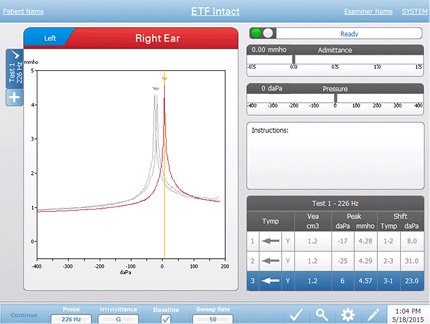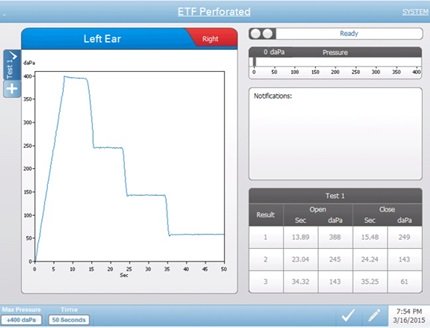Eustachian Tube Function
Tympanometry Guides
Eustachian Tube Function (ETF) Testing

Intact
One purpose of the Eustachian tube is to equalize pressure between the middle ear space and ambient pressure. Normally, the Eustachian tube temporarily opens during a swallow or yawn; thereby, allowing an exchange of air between the middle ear and the nasopharynx. Between swallows, slight fluctuations may occur in the pressure level within the middle-ear since the cells which line the middle-ear absorb air from the cavity. If the Eustachian tube should remain closed for an extended period of time, a negative pressure (relative to atmospheric pressure) may develop within the middle-ear. This causes the tympanic membrane to retract inward, thus stiffening the eardrum. (Air pressure is decreased at the rate of 50 mm H2O/hour if the tube remains closed.) In time, fluid may develop within the middle-ear space further stiffening the middle-ear system and reducing the ability of the ossicular chain to conduct sound to the cochlea. Since a malfunctioning Eustachian tube can lead to middle-ear disease and hearing loss, it is helpful to be able to determine the patency of the Eustachian tube in patients who are susceptible to middle-ear problems.
Pressure-swallow test
The purpose of this test is to try to force the Eustachian tube to open through use of pressure gradients and swallowing on the part of the patient. A series of three tympanograms are obtained under the three different conditions described below.
NOTE
In each case, to avoid the effects of hysteresis, the tympanogram is recorded in the SAME sweep direction.
Condition #1:
A tympanogram sweep is performed with the normal pressure range selected (+ 200 to - 400 daPa).
Condition #2:
A positive pressure of 400 daPa is established within the ear canal, and the eardrum is pushed inward. As this membrane moves inward, the volume of the middle-ear space is reduced. This, in turn, causes air that is present within the middle-ear space to be more compressed, so that as the patient swallows and the Eustachian tube opens, more air than normal flows out of the middle ear. When the Eustachian tube closes and the ear canal is no longer subjected to induced positive pressure, less air than normal is present within the middle ear space. In other words, there is negative pressure within the middle ear. Therefore, when the second tympanogram is recorded, the point of peak mobility will be shifted in the negative direction (approximately 15 to 20 daPa) relative to the point of peak mobility recorded during the first tympanogram.
Condition# 3
A negative pressure of 400 daPa is established within the ear canal. As the pressure is reduced within the ear canal, the eardrum moves outward. Stressing the membrane outward leads to a temporary increase in middle-ear cavity volume. When the same amount of air is present within a larger volume, the air pressure within the cavity is reduced. Thus, the middle-ear pressure is negative relative to atmospheric pressure. As the patient drinks some water and the Eustachian tube opens, more air than normal will flow into the middle-ear space. When the Eustachian tube closes and the ear canal is vented, a positive pressure condition will exist within the middle ear relative to atmospheric pressure. When the third tympanogram is recorded, the point of peak mobility will be shifted in the positive direction (approximately 15 to 20 daPa) relative to the first tympanogram.
NOTE
If the Eustachian tube is functioning properly, a shift in the pressure peak of approximately 15 to 20 daPa in either direction will be observed. However, if the Eustachian tube is malfunctioning, there will be little, if any, observable difference in the pressure peak recorded from Condition #1, to Condition #2, to Condition #3.
Perforated

The operator may follow a protocol similar to that outlined by Holmquist for determining patency of the Eustachian tube in a patient with pressure equalization tubes in place or with a perforated eardrum. During the test, positive (or negative pressure is presented to the ear canal/middle-ear space until a pre-selected pressure limit is reached. The purpose of this test is to determine if the Eustachian tube will open as a direct result of this pressure. Specific opening pressure provides some information about the status of the tube (i.e., properly functioning vs. malfunctioning). It is suggested that the operator perform the ETF test with the maximum pressure (+400 daPa) pre-selected. This eliminates the possibility of the Eustachian tube not opening at a lower pressure which might otherwise be forced open closer to the maximum pressure value. If the tube opens as a direct result of the pressure within the ear canal/middle ear space, only a portion of the positive pressure will escape before the tube closes again.
NOTE
If negative pressure is used during the test and the tube opens, some air will enter the ear canal/middle-ear, thereby, reducing the amount of negative pressure. To further check the Eustachian tube function while a pressure gradient exists between the ear canal/middle-ear space and the nasopharynx, the patient is asked to swallow some water. If the tube is functioning properly, some air pressure will be released as the patient swallows the water. If the tube is malfunctioning, very little (if any) pressure will be released. Thus, it is possible to record changes in pressure when the Eustachian tube opens and closes in response to swallowing as a function of time.